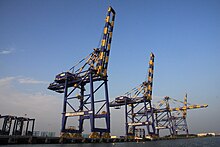Container crane: Difference between revisions
Jeremy112233 (talk | contribs) No edit summary |
Restocking (talk | contribs) Removed non-working link to domain that was for sale. |
||
| Line 48: | Line 48: | ||
==References== |
==References== |
||
{{Reflist}} |
{{Reflist}} |
||
==External links== |
|||
*[http://www.portvision.eu/BrowseKb.aspx?groups=22 Container cranes database at [[Portvision]]] |
|||
{{Intermodal containers}} |
{{Intermodal containers}} |
||
Revision as of 14:24, 23 September 2013

A container crane (also container handling gantry crane or ship-to-shore crane) is a type of large dockside gantry crane found at container terminals for loading and unloading intermodal containers from container ships.

Container cranes consist of a supporting framework that can traverse the length of a quay or yard, and a moving platform called a "spreader". The spreader can be lowered down on top of a container and locks onto the container's four locking points ("cornercastings"), using a twistlock mechanism. Cranes normally transport a single container at once, however some newer cranes have the capability to pick up two to four 20-foot containers at once.
Types
There are two common types of container handling gantry crane: high profile, where the boom is hinged at the waterside of the crane structure and lifted in the air to clear the ships for navigation, and low profile, where the boom is shuttled towards and over the ship to allow the trolley to load and discharge containers. Low profile cranes are used where they may be in the flightpath of aircraft such as where a container terminal is located close to an airport.
Sizes

Container cranes are generally classified by their lifting capacity, and the size of the container ships they can load and unload containers.
Panamax
A "Panamax" crane can fully load and unload containers from a container ship capable of passing through the Panama Canal (ships 12–13 containers wide).
Post Panamax
A "Post-Panamax" crane can fully load and unload containers from a container ship too large (too wide) to pass through the Panama Canal (normally about 18 containers wide).
Super-Post Panamax
The largest modern container cranes are classified as "Super-Post Panamax" (for vessels of about 22 or more containers wide). A modern container crane capable of lifting two 20-foot (6.1 m) long containers at once (end-to-end) under the telescopic spreader will generally have a rated lifting capacity of 65 tonnes. Some new cranes have now been built with 120 tonne load capacity enabling them to lift to four 20-foot (6.1 m) or two 40-foot (12 m) containers. Cranes capable of lifting six 20-foot-long containers have also been designed. Post-Panamax cranes weigh approximately 800–900 tonnes while the newer generation Super-PostPanamax cranes can weigh 1600–2000 tonnes.
Smaller sizes
Smaller sizes of container cranes, such as small straddle carriers, are used at railway sidings to transfer containers from flatcars and well cars to semi-trailers or vice versa. Both the rolling stock and the trailers may pass under the base. Smaller sizes of container cranes are also used at break-of-gauge transloading facilities.
Operation


The crane is driven by an operator that sits in a cabin suspended from the trolley. The trolley runs along rails that are located on top or sides of the boom and girder. The operator runs the trolley over the ship to lift the cargo which generally are containers. Once the spreader locks onto the container, the container is lifted and moved over the dock and placed on a truck chassis (trailer) to then be taken to the storage yard. The crane will also lift containers from chassis on the dock to load them onto the ship.
Straddle carriers, sidelifts, reach stackers, or container lorries then manoeuvre underneath the crane base, and collect the containers—rapidly moving the containers away from the dock and to a storage yard. Flatcars or well cars may also be loaded directly underneath the crane base.
Power
A crane can be powered by two types of power supply; by a diesel-engine driven generator located on top of the crane or by electric power from the dock. The most common is by electric power from the dock (also known as shore power). The voltage required may range from 4,000 up to 13,200 volts.
History
Cranes were used in harbors starting in the Middle Ages – see crane: harbor usage and list of historical harbour cranes. Modern intermodal containerization emerged in the mid-1950s, emerging from transport strategies developed in the Second World War and the Korean War, and specialized cranes parallelled developments in containerization.
In popular culture, container cranes are occasionally called AT-AT cranes due to their resemblance to AT-AT walkers in George Lucas's Star Wars films, although Lucas denies their inspiration.[1]
See also
References
- ^ Hartlaub, Peter (27 June 2011). "Nah, dude, they weren't cranes". San Francisco Chronicle.

